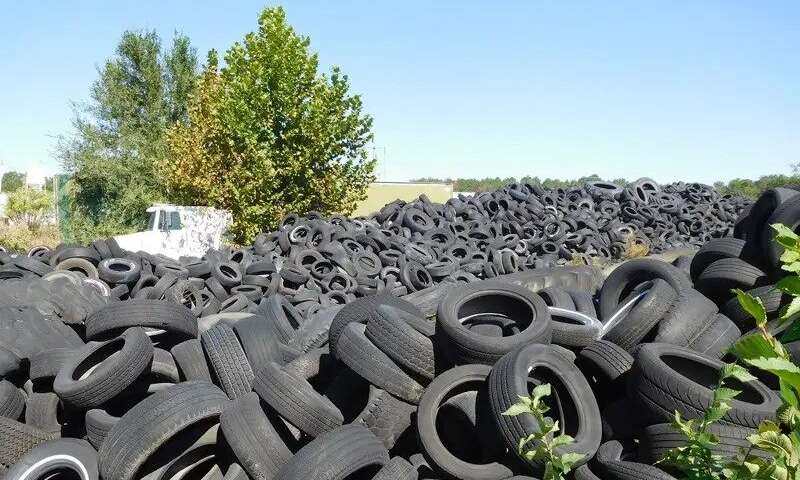
Tires catapult our cars and
trucks down the highway at speeds greater than 70 miles per hour, typically for
at least 50,000 miles. They must grip the road even in wet and icy conditions.
No wonder tires are difficult to recycle.
"Tires are a unique and large waste stream," said Jennie Saxe, assistant professor in the Department of Civil and Environmental Engineering at the University of Delaware. "They represent an achievement of materials science and engineering."
Besides rubber, they contain steel, manufactured chemicals, textiles and filler compounds. That's why it's a challenge to find something beneficial to do with the more than 750,000 waste tires produced just in Delaware every year.
Delaware was one of the last states to develop scrap tire regulations, and there was the issue of what to do with the stockpile of waste tires. Stacked waste tires are an environmental hazard. They can trap precipitation, leaving thousands of stagnant pools in which potentially disease-causing mosquitoes can breed. If a tire pile catches fire, it can burn for weeks or months.
Scrap tires in Delaware are transported to Maryland, Pennsylvania, New York and Virginia for recycling and use as tire-derived fuel. Scrap tires are also processed in New Castle, DE.
In spring 2020 staff of the Scrap Tire Program in Delaware's Department of Natural Resources and Environmental Control (DNREC) came to the Delaware Environmental Institute (DENIN) at the University of Delaware on the recommendation of other DNREC staff who had previously worked with DENIN researchers. Nicole Hill, environmental program manager of the Scrap Tire Program, was looking for different ways to handle this waste stream, to better understand the pros and cons of different potential uses, and to identify potential future business opportunities in this reuse.
"The Scrap Tire Program is very small," said Hill. "We have four employees, and we're tasked with monitoring compliance among generators and also facilitating cleanup at existing tire piles, so our time to look at other things is very limited."
"At DENIN, one of our goals is to foster collaborations," said Jeanette Miller, DENIN's associate director for interdisciplinary programs. "We try to connect faculty expertise, student learning, and the needs of our government agencies, all to develop more sustainable, economically beneficial solutions."
DENIN administrators identified Saxe as an ideal leader for the project.
"Delaware is so small," said Saxe, "that there's a unique opportunity for state regulators to turn to the university and say we need this research and for it to happen very quickly. This whole thing happened in less than a year. In Delaware, you can make the connections between real problems, regulatory agencies and university research in a relatively short period of time."
Saxe recruited Hannah Kirk, a senior in the energy and environmental policy program, for the project. Kirk's background was ideal. "The project reinforced the connections between engineering as a source of technical solutions and policy as a lever to get those solutions out into the world," Saxe said. "I was looking for a student who could handle the technical piece of this and also look at this through a policy lens."
Kirk had previously done statistics-based research, but was interested in this project because it offered a policy research angle that she hadn't explored before.
Kirk delved into the various ways other states and countries are using scrap tires. She found that use in tire-derived fuel, ground rubber, and civil engineering applications such as road construction, retaining and sound-proofing walls, and erosion prevention structures are most common. She researched how different states and countries deal with waste tires and how scrap tire funds are used in different states.
Saxe looked at possible uses in the context of Delaware's economic development plan. She explored how potential scrap tire uses might connect with other environmental or economic priorities or manufacturing opportunities in the state. She also addressed the need to develop reuse options acceptable to the public and identified potential future studies, such as a life cycle assessment of some of the alternative use options from manufacturing to ultimate disposal.
"The final report was more inclusive even than we anticipated," said Hill. DNREC staff will use it to determine if Delaware should tweak its scrap tire regulations. The final report also gave staff ideas for collaborators for future projects, such as the Delaware Department of Transportation, for the various uses of scrap tires in roadway construction.
Many benefits accrued from this collaborative research project facilitated by DENIN. "Hannah got real experience on a real project," said Saxe. "Her work may help the state reduce the environmental impacts of handling this waste stream."
Kirk also benefited from the mentor relationship with Saxe. "She really cared about teaching me skills I could use in the future," said Kirk. Saxe taught Kirk to use a citation management database and helped her develop a data management plan, which will be useful in her future studies.
Kirk reported that this research experience made her more confident in what she wants to do after graduation. It helped cement her interest in a future in environmental law.

 Previous page
Previous page Back to top
Back to top







